A new type of Nb (Ta)–Zr(Hf)–REE–Ga polymetallic deposit in the late Permian coal-bearing strata,
- 格式:pdf
- 大小:913.43 KB
- 文档页数:9
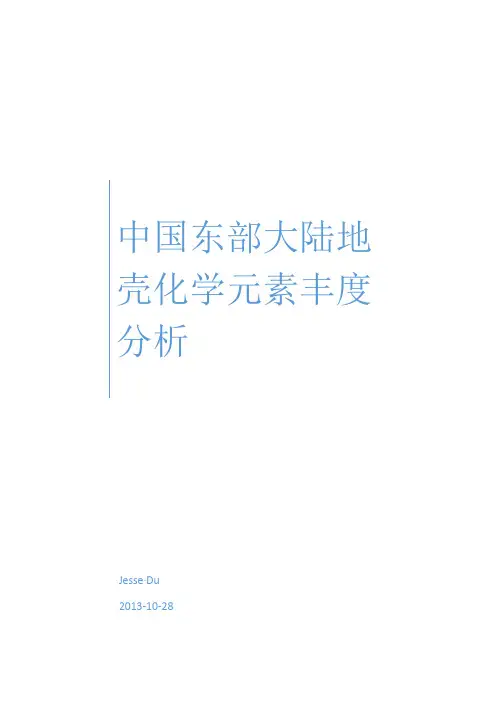
中国东部大陆地壳化学元素丰度分析Jesse·Du2013-10-28中国东部大陆地壳化学元素丰度分析摘要:本文通过对中国东部、内蒙兴安—吉黑造山带、华北地台以及华东南地块的总陆壳、上陆壳、中下陆壳元素丰度的文献数据值进行整理分析,主要着眼于特征元素之间的差别对不同地区的不同层次地壳元素丰度进行对比分析,得出一系列结论。
文章从亲石元素、亲铁元素、亲铜元素、亲生物元素以及稀土元素入手,总结了元素变化的一般规律,研究了其地质意义并总结了地球丰度的意义。
关键词:大陆地壳元素丰度变化规律地质意义0、引言大陆地壳是在地质历史过程中通过地幔部分熔融的岩浆向上侵入或喷出逐步形成的,部分熔融形成地壳后残余的地幔部分就成了现今的贫化或亏损地幔。
大陆地壳覆盖地球表面的45%,主要表现为大陆、大陆边缘海以及较小的浅海。
地壳的化学组成以硅铝质为特点,可分为两大类岩石:一类是地壳上部的相对未变形的沉积岩或火山岩堆积,另一类是已经变形变质的沉积岩、火成岩和变质岩带。
后者构成地球表面的山脉或在地壳深部,前者多在地壳表层的盆地及其边缘。
地壳可以承受强烈的板块构造运动,所以目前能寻找到38亿年前的地壳。
元素克拉克值反映了地壳的平均化学成分,确定着地壳作为一个物理化学体系的总特征以及地壳中各种地球化学过程的总背景。
它既是一种影响元素地球化学行为的重要因素,又为地球化学提供了衡量地壳体系中元素集中分散程度的标尺。
本文立足于中国东部各构造单元前人的大量实测资料,有条理的选择并分析了部分化学元素丰度值差异。
对于前人的数据进行了综合性的整理分析,对于更好认识地壳组成以及地球化学元素丰度的重要性有着重要意义。
1、数据处理方法对所有地壳微量元素进行原始地幔标准化(除REE),对稀土元素进行球粒陨石标准化;在整个数据处理中,对数据含量单位进行了处理,使所有元素含量单位均为ppm;对所成表格纵坐标取对数刻度。
在本次实验中,我们主要对亲石元素、亲铁元素、亲铜元素、亲生物元素、稀土元素等五项进行了处理分析。
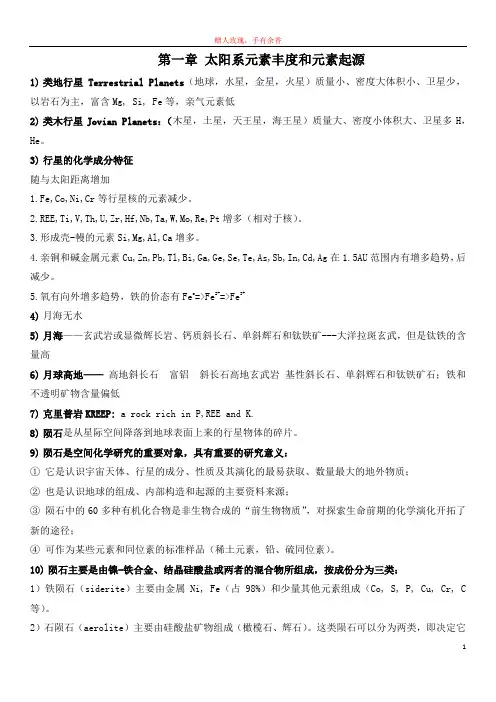
第一章太阳系元素丰度和元素起源1)类地行星Terrestrial Planets(地球,水星,金星,火星)质量小、密度大体积小、卫星少,以岩石为主,富含Mg, Si, Fe等,亲气元素低2)类木行星Jovian Planets:(木星,土星,天王星,海王星)质量大、密度小体积大、卫星多H,He。
3)行星的化学成分特征随与太阳距离增加1.Fe,Co,Ni,Cr等行星核的元素减少。
2.REE,Ti,V,Th,U,Zr,Hf,Nb,Ta,W,Mo,Re,Pt增多(相对于核)。
3.形成壳-幔的元素Si,Mg,Al,Ca增多。
4.亲铜和碱金属元素Cu,Zn,Pb,Tl,Bi,Ga,Ge,Se,Te,As,Sb,In,Cd,Ag在1.5AU范围内有增多趋势,后减少。
5.氧有向外增多趋势,铁的价态有Fe o=>Fe2+=>Fe3+4)月海无水5)月海——玄武岩或显微辉长岩、钙质斜长石、单斜辉石和钛铁矿---大洋拉斑玄武,但是钛铁的含量高6)月球高地——高地斜长石富铝斜长石高地玄武岩基性斜长石、单斜辉石和钛铁矿石;铁和不透明矿物含量偏低7)克里普岩KREEP: a rock rich in P,REE and K.8)陨石是从星际空间降落到地球表面上来的行星物体的碎片。
9)陨石是空间化学研究的重要对象,具有重要的研究意义:①它是认识宇宙天体、行星的成分、性质及其演化的最易获取、数量最大的地外物质;②也是认识地球的组成、内部构造和起源的主要资料来源;③陨石中的60多种有机化合物是非生物合成的“前生物物质”,对探索生命前期的化学演化开拓了新的途径;④可作为某些元素和同位素的标准样品(稀土元素,铅、硫同位素)。
10)陨石主要是由镍-铁合金、结晶硅酸盐或两者的混合物所组成,按成份分为三类:1)铁陨石(siderite)主要由金属Ni, Fe(占98%)和少量其他元素组成(Co, S, P, Cu, Cr, C 等)。
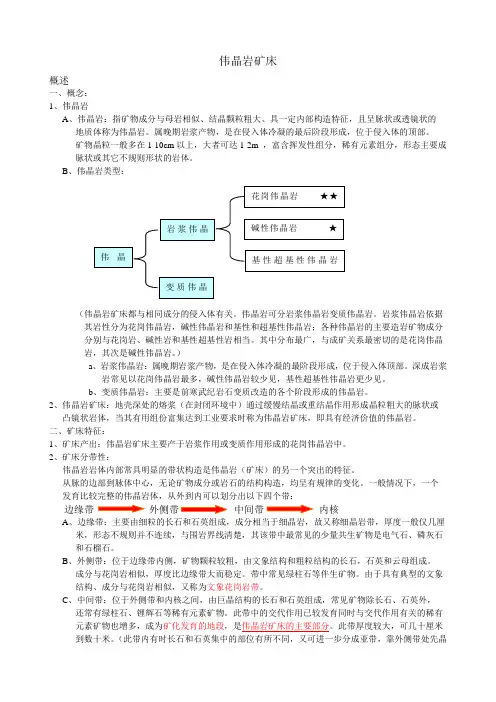
伟晶岩矿床概述一、概念:1、伟晶岩A 、伟晶岩:指矿物成分与母岩相似、结晶颗粒粗大、具一定内部构造特征,且呈脉状或透镜状的 地质体称为伟晶岩。
属晚期岩浆产物,是在侵入体冷凝的最后阶段形成,位于侵入体的顶部。
矿物晶粒一般多在1-10cm 以上,大者可达1-2m ,富含挥发性组分,稀有元素组分,形态主要成 脉状或其它不规则形状的岩体。
B 、伟晶岩类型:(伟晶岩矿床都与相同成分的侵入体有关。
伟晶岩可分岩浆伟晶岩变质伟晶岩。
岩浆伟晶岩依据 其岩性分为花岗伟晶岩,碱性伟晶岩和基性和超基性伟晶岩;各种伟晶岩的主要造岩矿物成分 分别与花岗岩、碱性岩和基性超基性岩相当。
其中分布最广,与成矿关系最密切的是花岗伟晶 岩,其次是碱性伟晶岩。
)a 、岩浆伟晶岩:属晚期岩浆产物,是在侵入体冷凝的最阶段形成,位于侵入体顶部。
深成岩浆 岩常见以花岗伟晶岩最多,碱性伟晶岩较少见,基性超基性伟晶岩更少见。
b 、变质伟晶岩:主要是前寒武纪岩石变质改造的各个阶段形成的伟晶岩。
2、伟晶岩矿床:地壳深处的熔浆(在封闭环境中)通过缓慢结晶或重结晶作用形成晶粒粗大的脉状或 凸镜状岩体,当其有用组份富集达到工业要求时称为伟晶岩矿床,即具有经济价值的伟晶岩。
二、矿床特征:1、矿床产出:伟晶岩矿床主要产于岩浆作用或变质作用形成的花岗伟晶岩中。
2、矿床分带性:伟晶岩岩体内部常具明显的带状构造是伟晶岩(矿床)的另一个突出的特征。
从脉的边部到脉体中心,无论矿物成分或岩石的结构构造,均呈有规律的变化。
一般情况下,一个 发育比较完整的伟晶岩体,从外到内可以划分出以下四个带:边缘带外侧带 中间带 内核A 、边缘带:主要由细粒的长石和石英组成,成分相当于细晶岩,故又称细晶岩带,厚度一般仅几厘 米,形态不规则并不连续,与围岩界线清楚,其该带中最常见的少量共生矿物是电气石、磷灰石 和石榴石。
B 、外侧带:位于边缘带内侧,矿物颗粒较粗,由文象结构和粗粒结构的长石,石英和云母组成。
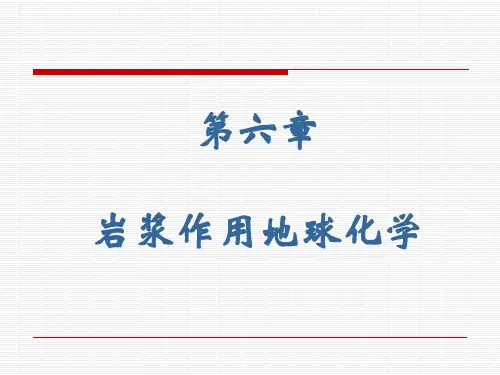
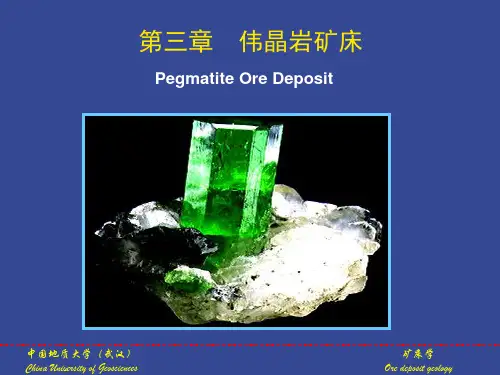
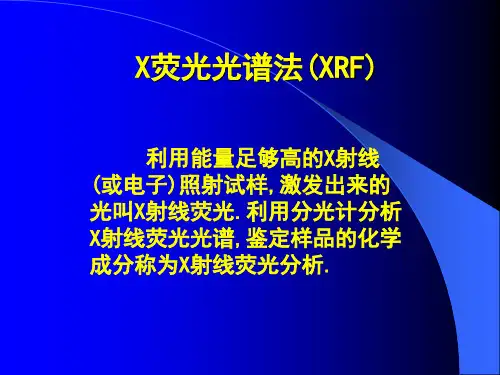
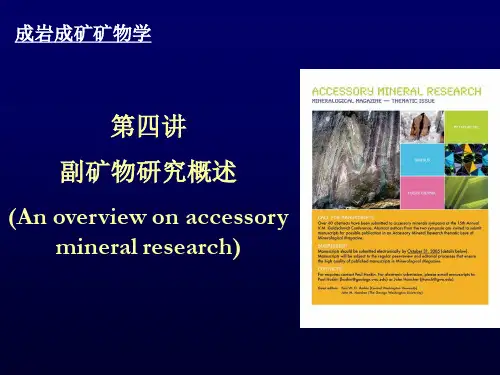
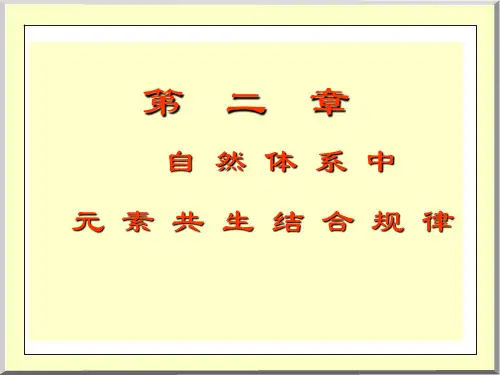
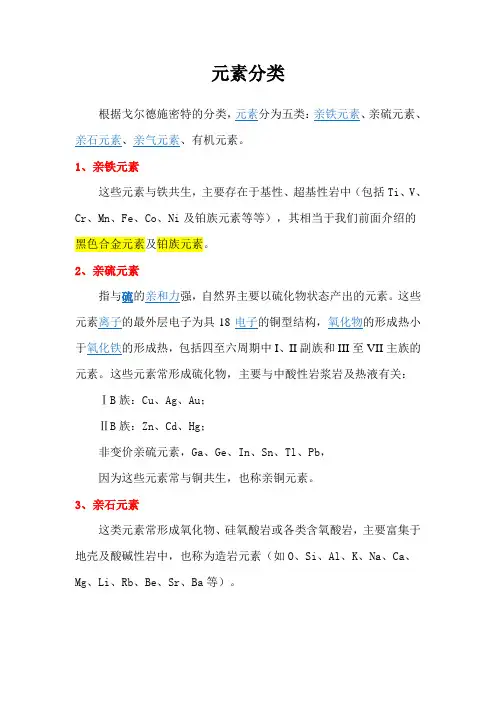
元素分类1、亲铁元素这些元素与铁共生,主要存在于基性、超基性岩中(包括Ti、V、Cr、Mn、Fe、Co、Ni及铂族元素等等),其相当于我们前面介绍的黑色合金元素及铂族元素。
2、亲硫元素于氧化铁的形成热,包括四至六周期中I、II副族和III至VII主族的元素。
这些元素常形成硫化物,主要与中酸性岩浆岩及热液有关:ⅠB族:Cu、Ag、Au;ⅡB族:Zn、Cd、Hg;非变价亲硫元素,Ga、Ge、In、Sn、Tl、Pb,因为这些元素常与铜共生,也称亲铜元素。
3、亲石元素这类元素常形成氧化物、硅氧酸岩或各类含氧酸岩,主要富集于地壳及酸碱性岩中,也称为造岩元素(如O、Si、Al、K、Na、Ca、Mg、Li、Rb、Be、Sr、Ba等)。
碱土金属与碱金属元素都属于亲石元素,主要为成岩元素,Li、Be产于伟晶岩中;Na、Mg、Al、Si、K、Ca一般岩石矿物的主要组成元素;Rb、Cs、Sr、Ba、稀有金属可以形成独立矿物。
一些放射性元素U、Th、Ra也主要与亲石元素共生,尤其是与碱性岩元素共生。
一些稀有元素,Sc、Y、Zr、Hf、Nb、Ta、W、Mo、REE,一般形成氧化物,可以形成独立矿物或作为伴生微量元素出现。
4、亲气元素以气态为主要存在状态的元素,常易于形成易溶、易挥发的化合物,由于其较大的流动性,是有利于成矿元素的迁移富集的。
亲气元素是岩浆射气的主要成分:如B、C、N、O、F、P、S、Cl,包括主要的卤素元素,常与金属元素形成络合物或络阴离子:[FeOH]2+、[FeCl]2+、[FeCl3]1-、[FeSO4]1+、[Fe(SO4)2]1-、[CuCl2]-、[CuCl3]2-、[CuCl]1+、[Cu(S2O3)2]3-、[AgCl2]-、[Ag(NH2)2]2+、[Ag(S2O3)2]3-、[PbCl3]-、[ZnCl3]-、[ZnCl4]2-、[PbCl]1+、[ZnCl]1+;络阴离子可以增加金属元素的溶解度,因此也称为矿化剂或挥发性元素。
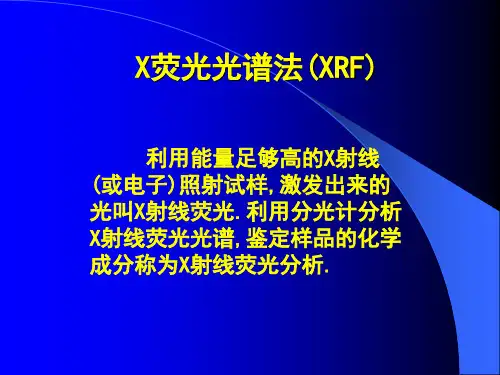
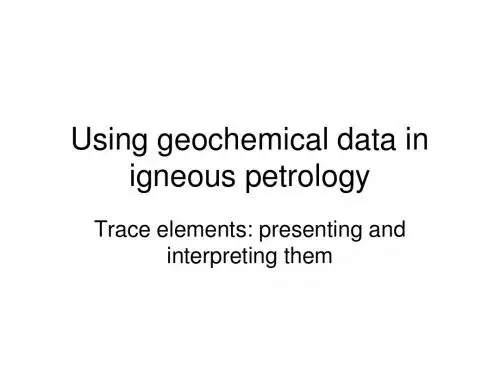
第一章克拉克值:元素在地壳中的丰度,称为克拉克值。
元素在宇宙体或地球化学系统中的平均含量称之为丰度。
丰度通常用重量百分数(%),PPM(百万分之一)或g/t表示。
2 .富集矿物:指所研究元素在其中的含量大大超过它在岩石总体平均含量的那种矿物。
3. 载体矿物:指岩石中所研究元素的主要量分布于其中的那种矿物。
4. 浓集系数 =工业利用的最低品位/克拉克值。
为某元素在矿床中可工业利用的最低品位与其克拉克值之比。
5.球粒陨石:是石陨石的一种。
(约占陨石的84%):含有球体,具有球粒构造,球粒一般为橄榄石和斜方辉石。
基质由镍铁、陨硫铁、斜长石、橄榄石、辉石组成。
划分为: E群——顽火辉石球粒陨石,比较稀少;O群——普通球粒陨石: H亚群—高铁群,橄榄石古铜辉石球粒损石;L亚群—低铁群,橄榄紫苏辉石球粒陨石; LL亚群—低铁低金属亚群;C群——碳质球粒陨石,含有碳的有机化合物和含水硅酸盐,如烷烃、芳烃、烯烃、氨基酸、卤化物、硫代化合物等。
为研究生命起源提供重要信息。
分Ⅰ型、Ⅱ型和Ⅲ型。
Ⅰ型其非挥发性组成代表了太阳系星云的非挥发性元素丰度。
6.浓度克拉克值=某元素在地质体中的平均含量/克拉克值,反映地质体中某元素的浓集程度。
1.陨石在地化研究中的意义:(一)陨石的成分是研究和推测太阳系及地球系统元素成分的重要依据:(1)用来估计地球整体的平均化学成分。
1陨石类比法,即用各种陨石的平均成分或用球粒陨石成分来代表地球的平均化学成分。
2地球模型和陨石类比法来代表地球的平均化学成分,其中地壳占质量的1%,地幔31.4%,地核67.6%,然后用球粒陨石的镍—铁相的平均成分加5.3%的陨硫铁可以代表地核的成分,球粒陨石的硅酸盐相平均成分代表地壳和地幔的成分,用质量加权法计算地球的平均化学成分。
(2)I型碳质球粒陨石其挥发性组成代表了太阳系中非挥发性元素的化学成分。
(二)陨石的类型和成分是用来确定地球内部具层圈结构的重要依据:由于陨石可以分为三种不同的陨石—石陨石、石铁陨石和铁陨石,因而科学家设想陨石是来自某种曾经分异成一个富含金属的核和一个硅酸盐外壳的行星体,这种行星经破裂后就成为各种陨石,其中铁陨石来自核部,石铁陨石来自金属核和硅酸盐幔的界面,而石陨石则来自富硅酸盐的幔区。
第五章微量元素地球化学基本概念及有关理论问题第一节微量元素的概念及分类在常见的地球化学文献中,人们常将O、Si、A1、Fe、Ca、Mg、Na、K、Ti等九种元素(它们的地壳丰度共占99%左右)以外的其它元素统称为微量元素或痕量元素、杂质元素、副元素、稀有元素、次要元素等(Trace,Minor,Micro,Rare,Oligo elements)。
它们在岩石中的含量一般在1%或o.1%以下(即低到W.诺达克和I.诺达克提出的所谓无所不存在的含量),含量单位常以10—‘或10—。
表示。
O’Ni皿s等将含量等于或小于10—’的任何一种元素称为痕量元素。
考虑到目前多数地球化学论文的习惯用法,本书采用微量元素一词,它包括痕量元素和微量元素。
然而,主要元素与微量元素的区分是相对的,常因具体的研究对象而异。
Gast(1968)t1“认为,微量元素是指不作为体系中任何相的主要组分(化学计量)存在的元素。
在化学作用过程中实际起作用的是摩尔浓度,因此,在地球化学中对微量元素概念的严格定义应是:只要元素在所研究客体(地质体、岩石、矿物等)中的含量低到可以近似地用稀溶液定律描述其行为,该元素可称为微量元素。
在矿物中,微量元素主要以下列形式存在:1.在快速结晶过程中陷入囚禁带内;2.在主晶格的间隙缺陷中;3.在固溶体中替代主要相的原子。
Goni和Gu山emin(1968)认为,可以把矿物中的微量元素按分布分成两组:1.可以取代某一矿物晶格中其它元素(类质同象置换)的微量元素;2.晶格以外的元素(晶间位置,如晶粒边界;晶内位置,如解理、裂隙等)。
目前,还没有建立对微量元素进行地球化学分类的统一标准,分类方案常因研究对象和研究目的不同而异。
60年代以前,一般沿用戈尔德施密特的元素地球化学分类系统,如亲石元素、亲铁元素、亲铜元素、亲气元素等。
有时则按它们在元素周期表中的位置以化学性质进行分类,如稀碱金属Li、Rb、Cs等;稀有元素Be、Nb、Ta、Zr、Hf等;稀土元素(La 系、Y);过渡族元素TME(Fe、Co、Ni、V、Ti、Cr、Cu)等。
微量元素地球化学Trace Element Geochemistry第0章绪论1.微量元素地球化学定义:地球化学的重要分支学科之一,是研究微量元素在地球( 包括部分天体)形成、演化中分布、赋存状态、行为方式、分析技术和各类应用的分支学科。
地壳主要由O 、Si 、Al 、Fe 、Ca 、Mg 、Na 、K 、Ti 等九种元素组成,这九种元素占地壳总重量的99%左右—【主要元素&常量元素】。
其它元素被统称为次要元素、微量元素、痕量元素、杂质元素或稀有元素等。
常量元素:能形成独立矿物,其分配受相律控制,遵循相律和化学计量法则。
•微量元素:自然体系中浓度极低,不能形成独立矿物,可以成为副矿物其分配不受相律和化学计量法则限制。
•major elements :地壳中平均浓度>1%○minor elements :地壳中平均浓度∈[0.1%,1%]○trace elements :地壳中平均浓度<0.1%,通常为ppm 或ppb 数量级○2.微量元素的定义:地球化学体系中,克拉克值低于0.1%的元素。
注:ppm=partspermillion=10-6;同理,ppb=10-9;ppt=10-12。
第一章微量元素的分类亲石元素(Lithophile elements )•一.戈式分类亲铁元素(Siderophile elements )•在岩石硅酸盐相中富集的化学元素。
在地球中它们明显富集在地壳内,在自然界中都以氧化物,含氧盐,特别是硅酸盐的形式出现,如硅、铝、钾、钠、钙、镁、铷、锶、铀、稀土元素等。
亲铜元素(Chalcophile elements )•富集于陨石金属相和铁陨石中的化学元素。
它们与氧和硫的结合能力均弱,并易溶于熔融铁中;在地球中相对于地壳和地幔,明显在地核内聚集。
典型的亲铁元素有镍、钴、金、铂族元素。
亲气元素(Atmophile elements )•在硫化物相和陨硫铁(FeS)中富集的化学元素。
A new type of Nb (Ta)–Zr(Hf)–REE –Ga polymetallic deposit in the late Permian coal-bearing strata,eastern Yunnan,southwestern China:Possible economic signi ficance and genetic implicationsShifeng Dai a ,⁎,Yiping Zhou b ,Mingquan Zhang b ,Xibo Wang a ,Jumin Wang b ,Xiaolin Song b ,Yaofa Jiang c ,Yangbing Luo a ,Zhentao Song a ,Zong Yang b ,Deyi Ren aa State Key Laboratory of Coal Resources and Safe Mining,China University of Mining and Technology,Beijing 100083,Chinab Yunnan Institute of Coal Geology Prospection,Kunming 650218,China cXuzhou Institute of Architectural Technology,Xuzhou 221116,Chinaa b s t r a c ta r t i c l e i n f o Article history:Received 1March 2010Received in revised form 14April 2010Accepted 14April 2010Available online 22April 2010Keywords:Nb(Ta)–Zr(Hf)–REE –Ga deposit Pyroclastic origin Coal-bearing strata Late Permian ageEastern Yunnan,ChinaThis paper describes a new type of Nb(Ta)–Zr(Hf)–REE –Ga polymetallic deposit of volcanic origin in the late Permian coal-bearing strata of eastern Yunnan,southwestern China.Well logging data (especially natural gamma-ray),geochemical data (high concentrations of Nb,Ta,Zr,Hf,REE,and Ga)and mineralogical compositions (Nb(Ta)-,Zr(Hf)-,or REE-bearing minerals rarely observed),together with the volcanic lithological characteristics indicate that there are thick (1–10m,mostly 2–5m)ore beds in the lower Xuanwei Formation (late Permian)in eastern Yunann of southwestern China.The ore beds are highly enriched in (Nb,Ta)2O 5(302–627ppm),(Zr,Hf)O 2(3805–8468ppm),REE (oxides of La –Lu +Y)(1216–1358ppm),and Ga (52.4–81.3ppm).The ore beds are mainly composed of quartz,mixed-layer illite –smectite,kaolinite,berthierine,and albite.Four types of ore beds in the study area were identi fied,namely,clay altered volcanic ash,tuffaceous clay,tuff,and volcanic breccia.Preliminary studies suggest that the high concentrations of otherwise rare metals were mainly derived from the alkalic pyroclastic rocks.The modes of occurrence,spatial distribution,and enrichment mechanism of the rare metals,however,require further study.©2010Elsevier B.V.All rights reserved.1.IntroductionNiobium and Ta are widely used in electronics,spacecraft production,mechanical manufacturing,and atomic reactor operation due to their special metallurgical characteristics,such as fatigue resistance,corrosion resistance,resistance to deformation,heat conduction,superconductivity,unipolar conduction,and gas absorp-tion properties (Kapoor et al.,2003;Valant et al.,2007;Guo and Wang,2009).Nb and Ta have long been regarded as geochemical “identical twins ”in fractionation processes linked with the evolution of the mantle and crust (Taylor and McLennan,1985;Hofmann,1988;Sun and McDonough,1989;Wedepohl et al.,1991;Green,1995).The two rare metals can be enriched in coal or coal-bearing strata under certain geological conditions,and if present in suf ficient quantities could be potentially utilized (Zhou et al.,1989,1994;Dai et al.,2007;Seredin and Finkelman,2008).Thus,understanding the concentra-tions and origins of Nb and Ta in coal-bearing strata is signi ficant both geochemically and economically.Generally there are four types of Nb –Ta ore deposits in nature,namely,pegmatite,pneumatolyto-hydrothermal,contact metamor-phic,and sur ficial deposits.The Nb-and Ta-bearing minerals of these ore deposits generally are niobite,pyrochlore,Ba-pyrochlore,fergu-sonite,and coltan (Wang et al.,1994;Green,1995;Horbe and da Costa,1999;Dostal and Chatterjee,2000;Pal et al.,2007;Guo and Wang,2009;Küster,2009).Owing to their similar geochemical characteristics,the elements Nb,Ta,Zr,Hf,and REE generally coexist in nature (Liu and Cao,1987;Zhou et al.,2000).The types of Nb –Ta ore deposits found in China consist of granite pegmatite,granite,and metamorphic high-temperature hydrothermal sedimentary deposits (Guo and Wang,2009).The granite pegmatite and granite deposits are the most important industrial Nb –Ta ore deposits;metamorphic high-temperature hydrothermal sedimentary deposits have not been mined economically in China (Guo and Wang,2009).High concentrations of Nb,Ta,Zr,Hf,and REEs in coal-bearing strata can be found but are not common (Tang and Huang,2004;Seredin and Finkelman,2008).The abundances of Nb,Ta,Zr,Hf,and REEs in coals are close to those in claystones in coal-bearing strata (Tang and Huang,2004).Ketris and Yudovich (2009)showed that theInternational Journal of Coal Geology 83(2010)55–63⁎Corresponding author.State Key Laboratory of Coal Resources and Safe Mining,China University of Mining and Technology,D11,Xueyuan Road,Haidian District,Beijing 100083,China.Tel./fax:+861062341868.E-mail address:daishifeng@ (S.Dai).0166-5162/$–see front matter ©2010Elsevier B.V.All rights reserved.doi:10.1016/j.coal.2010.04.002Contents lists available at ScienceDirectInternational Journal of Coal Geologyj o u r n a l ho m e p a g e :w w w.e l s ev i e r.c o m /l o c a t e /i j c o a l g e ocoal Clarke values of Nb,Ta,Zr,and Hf are3.7,0.28,36,and1.2ppm, respectively.Ronov et al.(1990)noted that Clarke values of Nb,Ta,Zr, and Hf in sedimentary rocks are7.6, 1.0,170,and 3.9ppm, respectively.Zhou et al.(2000)and Dai et al.(2007)showed that intra-coalbed alkalic tonsteins(3–5cm thickness)of the late Permian age were characteristically enriched in Nb,Ta,Zr,Hf,and Ga,as compared with acid and basic tonsteins;however,Nb-,Zr-,REE-and Ga-bearing minerals were rarely observed in the alkalic tonsteins (Zhou et al.,2000;Dai et al.,2007).In this paper,we report a new type of thick Nb(Ta)–Zr(Hf)–REE–Ga polymetallic ore bed in the late Permian coal-bearing strata of eastern Yunnan,southwestern China, which appears to have a volcanic origin similar to alkalic tonsteins in coal.2.Geological settingYunnan province is located in southwestern China(Fig.1).The strata in eastern Yunnan include the Xuanwuyan,Xuanwei(both Upper Permian),Kayitou,Feixianguan,and Yongningzhen Forma-tions(all Lower Triassic)(Dai and Chou,2007).Quaternary strata disconformably overlie the Yongningzhen Formation(China National Administration of Coal Geology,1996).The Xuanwei Formation(P2x)contains major coal-bearing strata in eastern Yunnan.It is mainly composed of greyfine-grained sand-stone,siltstone,silty mudstone,mudstone,and coal seams,as well as the thick polymetallic ore beds of pyroclastic origin described in this study(Fig.2).The Xuanwuyan Formation is characterized by green amygdaloidal basalt in the lower portion and tholeiitic basalt in the upper portion(Fig.2).Note that the polymetallic ore beds are located in the lower Xuanwei Formation(P2x1;Fig.2)where coals rarely occurred.The Kangdian Oldland is the major sediment source region for the coal basins situated in eastern Yunnan(Fig.1).In the northern part of eastern Yunnan,the sedimentary environments during late Permian varied west to east from Piedmont alluvial plain,through littoral alluvial plain(basal clinoform)to littoral plain.However,in the southern part of eastern Yunnan,epicontinental littoral clino-form,Luxi–Luoping submarine trench,and limited carbonate platform depositional environments occurred(Dai et al.,2008a). The northern Vietnam Oldland,located to the southernmost part of eastern Yunnan,is the dominant sediment source region for the limited carbonate platform in southeastern Yunnan(Fig.1;Dai et al.,2008a,b).The Lower Triassic formations and their depositional environ-ments were described in detail by Dai et al.(2008a).3.Samples and methodsWell logging data,including natural gamma-ray,apparent resis-tivity,and density profiles of the Xuanwei Formation were collected from more than300drill holes in eastern Yunnan.Previous ex-perience indicates that coals containing alkalic tonsteins with high concentrations of Nb,Ta,Zr,Hf,REE,and Ga usually have positive natural gamma-ray anomalies(Zhou,1994;Dai et al.,2007);thus, based on the comparison of lithologic character of core samples and the physical properties(especially natural gamma-ray data;for example,the positions of the collected samples in the borehole from Qujing area are792.9–793.05m and198.44–801.25m,Fig.2)Fig.1.Depositional environments of the late Permian in eastern Yunnan Province,China.I,Kangdian Oldland;II,northern Vietnam source region;1,Piedmont alluvial plain; 2,littoral alluvial plain(basal clinoform);3,littoral plain.4,Epicontinental littoral clinoform.5,Luxi–Luoping submarine trench.6,Limited carbonate platform(Dai et al.,2008a). 56S.Dai et al./International Journal of Coal Geology83(2010)55–63obtained from well logging,core samples were collected that mainly corresponded to the positive natural gamma-ray anomalies in the sequence (Fig.2).Samples from strata underlying and overlying the selected core samples were also collected for comparative purposes.In this study,data from three typical areas,Qujing (well no.2009-BX-4;samples from top to bottom are BX-B1to BX-B14),Zhenxiong (well no.2009-YN-5;samples from top to bottom are YN-1to YN-43),and Zhaotong counties (well no.2009-LY-10;samples from top to bottom are LY-1to LY-5)in eastern Yunnan are described.Note that we have limited permissions regarding these samples;therefore,the well number was shortened and the full number is not provided.The minerals were identi fied by microscopic analysis under transmitted light and by powder X-ray diffractometry (XRD).The XRD analysis was performed on a powder diffractometer with a Ni-filtered Cu-K αradiation and a scintillation detector.The XRD pattern was recorded over a 2θinterval of 2–70°,with a step size of 0.02°.The samples were ground to less than 200mesh for geochemical analyses,and were digested using an UltraClave Microwave High Pressure Reactor.The basic load for the digestion tank was composed of 330ml distilled H 2O,30ml 30%H 2O 2,and 2ml 98%H 2SO 4.The reagents for sample digestion were 5ml 65%HNO 3and 1ml 40%HF.Initial nitrogen pressure was set at 50bars and the highest tem-perature was set at 240°C.Inductively-coupled plasma mass spec-trometry (ICP-MS)was used to determine the concentrations of Nb,Ta,Zr,Hf,REE,and Ga in samples,following the general guidelines for ICP-MS (DZ/T0223-2001,2001).4.Results and discussion4.1.Enrichment of (Nb,Ta)2O 5,(Zr,Hf)O 2,REE (La –Lu+Y),and Ga Tables 1and 2list the concentrations of (Nb,Ta)2O 5,(Zr,Hf)O 2,REO (La –Lu+Y),and Ga in vertical sections through the ore beds of the late Permian coal-bearing strata in the Qujing,Zhenxiong,and Zhaotong areas,as well as the averages for each section and com-parisons with Chinese industrial standards.As compared with the upper continental crust reported by Rudnick and Gao (2004),the concentrations of Ga and the oxides of these rare metals are high in the ore beds.Based on the Chinese industry standards,Speci fications for Rare Metal Mineral Exploration (DZ/T 0203-2002,2002)and Speci fications for Rare Earth Mineral Exploration (DZ/T 0204-2002,2002),the required (Nb,Ta)2O 5concentrations for marginal and industrial grade Nb(Ta)ore deposits of weathered crust type are 80–100ppm and 160–200ppm,respectively;equivalent concentrations are 40–60ppm and 100–120ppm for the Nb(Ta)ore deposits of river placer type (Table 2).The concentration of (Nb,Ta)2O 5in the ore deposits from eastern Yunnan is therefore much higher than that of marginal and industrial grade weathered crust and river placer deposit types.Additionally,the concentrations of rare metals of (Zr,Hf)O 2,REO,and Ga are also up to the standards of ore mineralization or industrial utilization (Committee of National Reserves,1987;DZ/T 0203-2002,2002;DZ/T 0204-2002,2002).4.2.Ore bed characteristicsThe polymetallic ore beds,with thicknesses of 1–10m and mostly 2–5m,all occur in the lower Xuanwei Formation (P 2x 1).However,the ore beds were all described in the past as normal sedimentary rocks (such as mudstone,siltstone,or silty mudstone)during drill core sample identi fication and description.The macrolithology of the ore beds can nevertheless be differentiated from more normal sedimentary rocks as described below.Moreover,compared to the normal sedimentary rocks in the sequence,natural gamma-ray data of the ore beds show a signi ficant positive anomaly in well logging (Fig.2),probably due to high concentrations of U and Th and their decay products,as well as the radioactive isotope of potassium (40K)(Zhou et al.,2000).Evaluation of core sample lithology and well logging data from more than 300drill holes indicate that such ore beds are widely distributed in the lower Xuanwei Formation from eastern Yunnan and from some areas of western Guizhou and southern Sichuan provinces.In most cases,the petrology,mineralogy,and geochemistry of the ore beds are similar to those of intra-seam alkalic tonsteins.The geochemical and mineralogical differences between intra-seam alkalic and intra-seam acid/medium-acid tonsteins in eastern Yunnan,western Guizhou,and Chongqing are detailed described by Zhou etal.Fig.2.The Xuanwuyan and Xuanwei Formations in Qujing area and the natural gamma-ray logging curve.57S.Dai et al./International Journal of Coal Geology 83(2010)55–63(2000)and Dai et al.(2007).Both the ore beds and the intra-seam tonstein bands are of pyroclastic origin and are characterized by high concentrations of Nb,Ta,Zr,Hf,REE(La–Lu+Y),and Ga.The high Nb/Ta and Zr/Hf ratios of the core samples from Qujing (average17.4and39,respectively),Zhenxiong(average15.7and 53.9),and Zhaotong(average14.5and43.5)provide evidence thatTable1Concentration of rare metals in the ore beds from eastern Yunnan(ppm).Sampleno.Nb2O5Ta2O5ZrO2HfO2La2O3Ce2O3Pr2O3Nd2O3Sm2O3Eu2O3Gd2O3Tb2O3Dy2O3Ho2O3Er2O3Tm2O3Yb2O3Lu2O3Y2O3REO GaQujing areaBX-B155125.261241456110713.25318.0 1.2624.9 6.5344.18.1724.7 3.8523.9 3.3229168350.7 BX-B258233.271541699719623.19326.1 1.8135.38.2950.39.0725.3 3.6322.6 3.234093563.0 BX-B342122.8488411039281110840570.9 2.5251.08.645.57.7322.1 3.0518.8 2.66263221182.1 BX-B457728.065801459523528.210625.5 1.6229.57.3249.69.7531.0 5.1832.2 4.6430796853.0 BX-B574834.3727416442293511643582.1 3.1764.912.076.414.341.4 6.0435.6 5.11448269789.5 BX-B651823.754531137015717.46519.6 1.5223.5 5.4833.1 5.9820.7 3.623.7 3.4519264241.0 BX-B754527.4623714414933942.717339.8 2.4937.37.8444.57.7721.2 3.0620.0 2.87254114461.0 BX-B847422.351151156817021.88723.3 1.7726.6 6.1737.3 6.8521.7 3.320.5 2.8923573140.3 BX-B966934.9782516541088211543381.3 3.066.512.672.412.536.8 5.3829.0 4.01395255992.1 BX-B1035016.8351386.713830136.513931.0 1.6428.0 5.434.6 6.4420.1 3.1421.2 3.1319796639.0 BX-B1141119.7423310214333642.516835.7 2.2133.1 6.0136.5 6.821.8 3.3920.8 3.14217107649.0 BX-B1235917.9403290.98419425.59721.1 1.3722.3 4.8329.5 5.5417.6 2.7417.1 2.6317570136.8 BX-B1358929.2665014911528836.214333.1 2.1735.08.2456.511.333.2 5.0330.0 4.38371117253.7 BX-B1461128.9721615742382310237374.8 4.0365.411.775.915.044.6 6.5338.2 5.58467253185.2 Average52926.0587813319141252.019841.6 2.1838.87.9349.09.0827.3 4.1425.3 3.64297135859.7 Zhenxiong areaYN-121311.5260847.211521826.410219.4 6.3517.4 2.8115.6 2.767.8 1.348.8 1.317962447.5 YN-241142.3104161795511813.55526.47.4053.011.6374.013.8639.3 6.4638.8 5.6643795558.6 YN-31577.39166329.79018518.5599.4 1.9812.7 2.1612.7 2.33 6.8 1.237.8 1.156247237.0 YN-447828.9677811422450660.021537.2 4.5442.47.9347.69.1426.1 4.1926.1 3.79295150866.5 YN-519611.0246842.114726833.112422.6 3.5821.0 3.3819.5 3.6010.3 1.6210.2 1.4910977838.3 YN-61639.20196033.015628235.212620.6 3.8314.6 2.5716.1 3.2510.0 1.6710.6 1.568877247.1 YN-722612.8287046.016929237.214729.3 6.1427.2 4.2022.7 4.0111.2 1.7410.2 1.4911087349.3 YN-838922.0544987.323743843.812519.0 2.8127.9 5.5936.47.0921.3 3.4922.0 3.25226121851.0 YN-943925.4629297.936570374.821829.8 4.0440.07.3343.68.2423.1 3.6122.8 3.35260180757.9 YN-1037219.8415963.027163876.228741.9 4.9632.5 5.7633.9 6.3718.8 2.9518.4 2.73215165554.8 YN-111728.91189929.5381307.4248.0 2.7211.4 1.738.1 1.34 3.40.54 3.50.514328438.8 YN-121779.38188829.46315314.35510.4 2.8111.8 1.859.2 1.50 3.90.59 3.80.574737942.4 YN-131527.66150622.211520322.57410.3 2.019.5 1.7510.8 2.10 6.10.98 6.00.896352832.8 YN-1434818.2462868.414823725.37414.3 3.3222.5 4.8128.8 5.2914.8 2.2213.9 2.0017777253.7 YN-1520311.0230337.322245852.415613.8 2.1215.7 2.7515.6 2.767.8 1.217.7 1.1488104743.9 YN-161698.70212233.78321830.715941.411.043.9 6.3729.8 4.6511.1 1.529.3 1.3313878944.2 YN-1718710.3240739.420464349.517530.39.1826.3 3.4917.3 2.868.0 1.238.0 1.1380126049.7 YN-181779.83210934.741683510839154.27.6031.0 3.5920.1 4.1413.6 2.2413.9 2.16140204258.7 YN-19116 6.09145222.49518521.98417.6 3.4617.4 2.4412.5 2.12 5.90.90 5.50.817252634.2 YN-2027614.9343956.88416619.16514.6 3.3320.9 3.4315.8 2.54 6.4 1.01 6.10.908849753.6 YN-2128316.9365561.29717917.95515.9 3.8821.7 3.5816.9 2.69 6.7 1.02 6.30.958751567.0 YN-22153489.62355133719135547.217665.710.710320.712221.557.68.2847.0 6.56754198684.5 YN-2325312.9286045.122833537.410213.5 1.6215.9 3.5124.8 5.1516.2 2.6315.4 2.2115595855.9 YN-2421511.7230239.723343057.320842.6 3.3532.0 4.4124.3 4.5614.1 2.3414.3 2.16136120858.1 YN-2526812.3294751.959311981857361419.4982.28.2838.3 6.8519.7 3.2320.2 3.0817*******.2 YN-2626214.3288346.923850272.732250.7 5.0127.0 4.4026.4 5.2116.5 2.3413.7 2.0517*******.3 YN-2722911.8214133.3810152121173367.5 6.7235.3 3.8120.8 4.1914.5 2.3515.4 2.41120356869.1 YN-2827514.6291953.719239846.518032.7 5.9724.7 4.0221.6 4.0410.5 1.539.4 1.40131106344.6 YN-2933318.5345158.518937243.514222.7 5.8626.2 3.9118.0 4.1512.8 1.9212.1 2.0415*******.2 YN-3021712.4244841.218231333.811217.5 4.0418.6 3.2217.0 2.667.4 1.06 6.80.968880745.4 YN-31119 6.75132420.616828634.911914.6 2.7911.8 1.7710.7 1.97 6.10.90 5.90.915972339.4 YN-3219611.1242239.411221624.39717.6 5.0416.1 2.6014.5 2.657.7 1.238.1 1.217259745.2 YN-3322713.2313950.923355266.421521.9 2.3921.4 3.7923.9 4.7113.8 2.2214.3 2.22141131840.4 YN-3438821.9569291.336667167.219428.2 3.1133.0 6.0538.17.4122.6 3.7624.3 3.70222169047.7 YN-352988.76232637.032570674.122521.0 1.9719.0 2.9218.5 3.9113.7 2.7119.6 3.31105154241.2 YN-3637819.2482976.323159464.326461.312.655.18.6249.59.6128.9 4.4328.6 4.51344176071.0 YN-3733216.7385261.824350849.216623.2 5.1427.2 5.0430.9 6.0917.5 2.7517.4 2.67194129857.4 YN-381657.74178030.012424728.810617.3 2.7714.4 2.3714.8 2.767.9 1.207.4 1.088166036.1 YN-391537.87177229.611023526.79515.5 2.6714.8 2.2712.7 2.21 6.00.95 5.80.917060044.4 YN-4050428.9715411516937533.511124.7 6.2128.6 3.9918.7 3.098.7 1.328.6 1.2410289566.6 YN-4122211.1308747.65212913.25413.1 3.5816.1 3.0317.6 3.047.9 1.197.5 1.159341580.9 YN-421709.60232537.413124926.78511.7 3.0612.4 2.2014.1 2.667.6 1.15 6.7 1.017863453.7 YN-4327315.5376159.931360110341610334.023456.236874.120127.615623.12856556756.3 Average28616.0374560.020541549.617730.6 5.4732.3 5.7333.8 6.4018.2 2.7616.8 2.51214121652.4 Zhaotong areaLY-124513.9295661.39715917.15513.1 3.1815.9 3.2620.1 3.5910.0 1.398.1 1.1611252048.1 LY-276848.8901819732471710239382.6 6.2466.913.178.214.641.6 6.236.853********.9 LY-361837.1968418460686910838661.5 3.8863.512.477.114.641.2 6.2538.2 5.64495278972.0 LY-444527.771961371473 4.326 6.4 1.49 4.70.93 6.3 1.26 4.20.75 5.80.833318499.7 LY-588544.4126512546520717.87730.2 4.5924.8 3.7219.7 3.7711.8 1.9813.6 2.0412******* Average59234.4830116722140549.818738.7 3.8835.1 6.6940.37.5421.8 3.3120.5 2.93226127181.3 58S.Dai et al./International Journal of Coal Geology83(2010)55–63the high rare metal concentrations were derived from alkalic volcanic ashes (Zhou et al.,1982,2000;Green,1995;Dai et al.,2007).Zhou (1994),Hong (1993),Zhou et al.(2000),and Dai et al.(2007;unpublished data)noted that intra-seam alkalic tonsteins in the late Permian coal-bearing strata from southwestern China have higher Nb,Ta,Zr,and Hf,and higher Nb/Ta and Zr/Hf ratios as well,as compared with silicic and ma fic tonsteins.For example,Hong (1993)found that alkalic tonsteins in late Permian coals of southern Sichuan province,located to the northern Yunann province,have 461ppm Nb 2O 5,40.3ppm Ta 2O 5and 9.59Nb/Ta ratio (five samples).Dai et al.(unpublished data)showed that the alkalic tonsteins in the late Permian coals of Songzao coal field,located to the northeastern Yunnan Province contain 494ppm Nb 2O 5and 29.8ppm Ta 2O 5and have a higher Nb/Ta ratio (9.29)(nine samples).The common Nb-,Zr-,REE-,and Ga-bearing minerals (e.g.,columbite,pyrochlore,samarskite,zircon,and hafnon)have been rarely observed in these ore beds either by XRD or under optical microscope,and thus it can be deduced that the rare metals probably occur as absorbed ions.Zhou et al.(2000)suggested that these elements occur as adsorbed ions in the alkalic tonsteins associated with the late Permian coals of southwestern China.Despite the similar geochemical and mineralogical compositions,the stratigraphic occurrence (lower portion of the Upper Permian and not intra-seam),greater thickness,and lesser degree of alteration and degradation differentiate the polymetallic ore beds from intra-seam tonstein bands.The intra-seam alkalic tonsteins usually have a thickness of 3–5cm and a full alteration/degradation from pyroclasts to kaolinite and a trace amount of mixed-layer illite –smectite.The contact between the ore beds and their underlying strata is abrupt.Figs.3and 4,for example,show the abrupt contact between the ore bed and its underlying carbargillite in the Qujing area of eastern Yunnan.The particle size of the pyroclastic ore bed decreases from bottom to top,showing a clear normal grading.The underlying carbargillite is a normal sedimentary rock and contains some plant fragments (Fig.5).However,plant fragments are found only rarely in the overlying ore bed.High-temperature quartz with well-developed crystal faces (Fig.6A),high-temperature cracks (Fig.6B),or with good embayed and/or sharp-edged outlines (Figs.4and 5)in the ore bed indicates a pyroclastic origin.Based on macroscopic and microscopic observations,four types of the ore beds have been identi fied.(1)Clay altered volcanic ash,in which the pyroclasts have a size less than 0.0625mm and show signi ficant alteration.The macrostructure is similar to that of dense tonsteins as described by Zhou et al.(2000)(Fig.7A).(2)Tuffaceous clay,with a particle size of 0.0625–1mm.A large proportion of the pyroclasts in the tuffaceous clay are altered,but some fragmental textures can still be seen at a macroscopic or microscopic scale (Fig.7B).(3)Tuff,with a particle size generally of 1–2mm and normal grading.Most of the pyroclasts in this material retain their original morphological features and have not been subjected to degradation(Fig.7C).The above three types of ore beds (1–3)are composed of quartz,mixed-layer illite –smectite,kaolinite,and berthierine.(4)Volcanic breccia,poorly sorted and with a particle size larger than 2mm (Fig.7D).The volcanic breccias are mainly composed of quartz,plagioclase (albite),mixed-layer illite –smectite,and berthierine.Carbonatization is very common in the volcanic breccia due to epigenetic hydrothermal fluids (Figs.8and 9).In most cases,the first and second types of the ore beds (types 1and 2above)are dominant in eastern Yunnan and the last two types (types 3and 4)occur only in localised parts of the lower Xuanwei Formation in the northeast of eastern Yunnan.It is suggested that the rare metals Nb,Ta,Zr,REE,and Ga in the ores were mainly derived from the alkalic pyroclasts;however,intergranular textures were also observed in the volcanic breccia,with some ma fic minerals in filling the voids structured by plagioclase (Fig.10);these indicate that the original magma was probably ma fic.The ma fic structure and the high concentrations of the rare metals derived from the alkaliic pyroclastic rocks indicate that the formation of ore beds was rather complicated.Table 2Concentration of rare metals in thick polymetallic ore beds from Qujing,Zhenxiong,and Zhaotong areas,as well as marginal and industry grades of deposits of weathering crust and river placer (ppm).SampleNumber of samples Thickness (m)(Nb,Ta)2O 5(Zr,Hf)O 2REO GaCoast sand depositWeathering crust deposit LREEsaHREE a Marginal grade n.a.0.5–1.0a ,0.5b 80–100a 40–60b 400–6003000500–1000300–500Industry grade n.a.160–200a 100–120b1600–24008000800–1500600–100030c ,20d 2009-BX-414 2.55556011135859.72009-YN-543163023805121652.42009-LY-10536278468127181.3a Weathering crust.b River placer.c Ga industrial grade in coal.dGa industrial grade inbauxite.Fig.3.The abrupt contact (macroscopic)between the ore beds and normal sedimentary carbargillite in Qujing area.59S.Dai et al./International Journal of Coal Geology 83(2010)55–635.ConclusionsPreliminary studies showed that Nb(Ta)–Zr(Hf)–REE –Ga polyme-tallic deposits,with a thickness of 1–10m and mostly 2–5m,in the lower late Permian coal-bearing strata (Xuanwei Formation),widely distribute in eastern Yunnan and probably in some areas of western Guizhou and southern Sichuan provinces of southwestern China.From the genetic view,the thick beds rich in Nb (Ta),Zr(Hf),REE,andFig.4.The abrupt contact (microscopic)between the polymetallic ore beds and normal sedimentary carbargillite in Qujing area,and high-temperature quartz as well.60S.Dai et al./International Journal of Coal Geology 83(2010)55–63Ga belong to a new type of ore deposit that has not been reported before.The high concentrations of otherwise rare metals were mainly derived from alkalic pyroclasts,similar to the intra-seam alkalic tonsteins in the late Permian coals from southwestern China.Four types of ore beds have been identi fied,namely clay altered volcanic ash,tuffaceous clay,tuff,and volcanic breccia.Minerals in the ore beds mainly consist of quartz,mixed-layer illite –smectite,kaolinite,berthierine,and albite.This study showed the preliminary data and recognition of the new ore deposit in southwestern China.The modes of occurrence,spatial distribution,enrichment mechanism,and extraction methods of the rare metals require deeper study and now are in progress.AcknowledgementsThis research was supported by the National Science Fund for Distinguished Young Scholars (no.40725008)and the National Natural Science Foundation of China (no.40725008,40831160520).Special thanks were given to a group of young men and young women in Yunnan Institute of Coal Geology Prospection for their help in sample collection.ReferencesChina Coal Geology Bureau,1996.Sedimentary Environments and Coal Accumulation oflate Permian Coal Formation in Western Guizhou,Southern Sichuan and Eastern Yunnan,China.Chongqing University Press,Chongqing.(in Chinese with English abstract).Committee of National Reserves,1987.Reference Handbook for Mineral IndustrialRequirements.Geological Press,Beijing (in Chinese).Dai,S.,Chou,C.-L.,2007.Occurrence and origin of minerals in a chamosite-bearingcoal of late Permian age,Zhaotong,Yunnan,China.American Mineralogist 92,1253–1261.Dai,S.,Zhou,Y.,Ren,D.,Wang,X.,Li,D.,Zhao,L.,2007.Geochemistry and mineralogy ofthe late Permian coals from the Songzao Coal field,Chongqing,southwestern China.Science in China Series D:Earth Science 50,678–688.Dai,S.,Tian,L.,Chou,C.-L.,Zhou,Y.,Zhang,M.,Zhao,L.,Wang,J.,Yang,Z.,Cao,H.,Ren,D.,2008a.Mineralogical and compositional characteristics of late Permian coals from an area of high lung cancer rate in Xuanwei,Yunnan,China:occurrence and origin of quartz and chamosite.International Journal of Coal Geology 76,318–327.Dai,S.,Ren,D.,Zhou,Y.,Chou,C.-L.,Wang,X.,Zhao,L.,Zhu,X.,2008b.Mineralogy andgeochemistry of a superhigh-organic-sulfur coal,Yanshan Coal field,Yunnan,China:evidence for a volcanic ash component and in fluence by submarine exhalation.Chemical Geology 255,182–194.Dostal,J.,Chatterjee,A.K.,2000.Contrasting behaviour of Nb/Ta and Zr/Hf ratios in aperaluminous granitic pluton_Nova Scotia,Canada.Chemical Geology 163,207–218.DZ/T 0203-2002,2002.Geology Mineral Industry Standard of P.R.China:Speci ficationsfor Rare Metal Mineral Exploration.Geological Press,Beijing.(in Chinese).DZ/T 0204-2002,2002.Geology Mineral Industry Standard of P.R.China:Speci ficationsfor Rare Earth Mineral Exploration.Geological Press,Beijing.(in Chinese).DZ/T0223-2001,2001.Geology Mineral Industry Standard of P.R.China:The GeneralAnalysis Rules for Inductively Coupled Plasma Mass Spectrometry.Geological Press,Beijing.(in Chinese).Green,T.H.,1995.Signi ficance of Nb/Ta as an indicator of geochemical processes in thecrust –mantle system.Chemical Geology 120,347–359.Guo,Q.W.,Wang,Z.X.,2009.Modern Metallurgy of Niobium and Tantalum,1–56.Metallurgical Industry Press,Beijing,pp.160–169(in Chinese).Hofmann,A.W.,1988.Chemical differentiation of the Earth:the relationship betweenmantle,continental crust,and oceanic crust.Earth and Planetary Science Letters 90,297–314.Hong,Z.,1993.Alkalic,medium,and acid tonsteins.In:Zhang,Y.(Ed.),SedimentaryEnvironments and Coal Accumulation of the late Permian Coal-bearing Strata of Southern Sichuan Province.Guizhou Science &Technology Press,Guiyang,pp.44–62(in Chinese with English abstract).Horbe,A.M.C.,da Costa,M.L.,1999.Geochemical evolution of a lateritic Sn –Zr –Th –Nb –Y –REE-bearing ore body derived from apogranite:the case of Pitinga,Amazonas —Brazil.Journal of Geochemical Exploration 66,339–351.Kapoor,K.,Vivekanand,K.,Gopalkrishna,T.,Sanyal,T.,De,P.K.,2003.High corrosionresistant Ti-5%Ta-1.8%Nb alloy for fuel reprocessing application.Journal of Nuclear Materials 322,36–44.Ketris,M.P.,Yudovich,Y.E.,2009.Estimations of clarkes for carbonaceous biolithes:world average for trace element contents in black shales and coals.International Journal of Coal Geology 78,135–148.Küster,D.,2009.Granitoid-hosted Ta mineralization in the Arabian –Nubian Shield:Oredeposit types,tectono-metallogenetic setting and petrogenetic framework.Ore Geology Reviews 35,68–86.Liu,Y.,Cao,L.,1987.Guidelines of Elemental Geochemistry.Publishing House ofGeology,Beijing,pp.57–80(inChinese).Fig.5.The normal sedimentary carbargillite containing a plant fragment (fusinite)and high-temperature quartz with embayed and sharp outlines in ore bed of Qujingarea.Fig.6.High-temperature quartz in the polymetallic ore beds.(A)High-temperature quartz with well-developed crystal faces;(B)high-temperature quartz with high-temperature crack.61S.Dai et al./International Journal of Coal Geology 83(2010)55–63。